Animal Research in Primates: A Review of Ethical Issues and Practices
VerifiedAdded on 2021/06/14
|16
|3580
|268
Report
AI Summary
This report provides an overview of animal research in primates, focusing on ethical considerations and scientific practices. The report begins with a broad scan of research journals and filing systems, followed by a focused review of relevant literature. It then delves into two selected papers, discussing problem definitions, proposed systems, and experimental designs. The report highlights the ethical issues surrounding the use of primates in research, including concerns about animal welfare, distress, and the potential for post-traumatic stress disorder. The report also explores the scientific benefits of using primates, such as their phylogenetic similarities to humans, which make them suitable candidates for studying diseases. The report emphasizes the need for ethical guidelines and practices to protect the welfare of primates used in research, including providing them with appropriate environments and minimizing distress. It also discusses the importance of minimizing the number of primates used for research and replacing more sentient species with less sentient ones. The report concludes by advocating for a humane system that treats animals under study with dignity, while acknowledging the scientific value of primate research. Statistics on the global use of animals for research, including primates, are also presented, along with discussions of specific examples and debates within the scientific community.
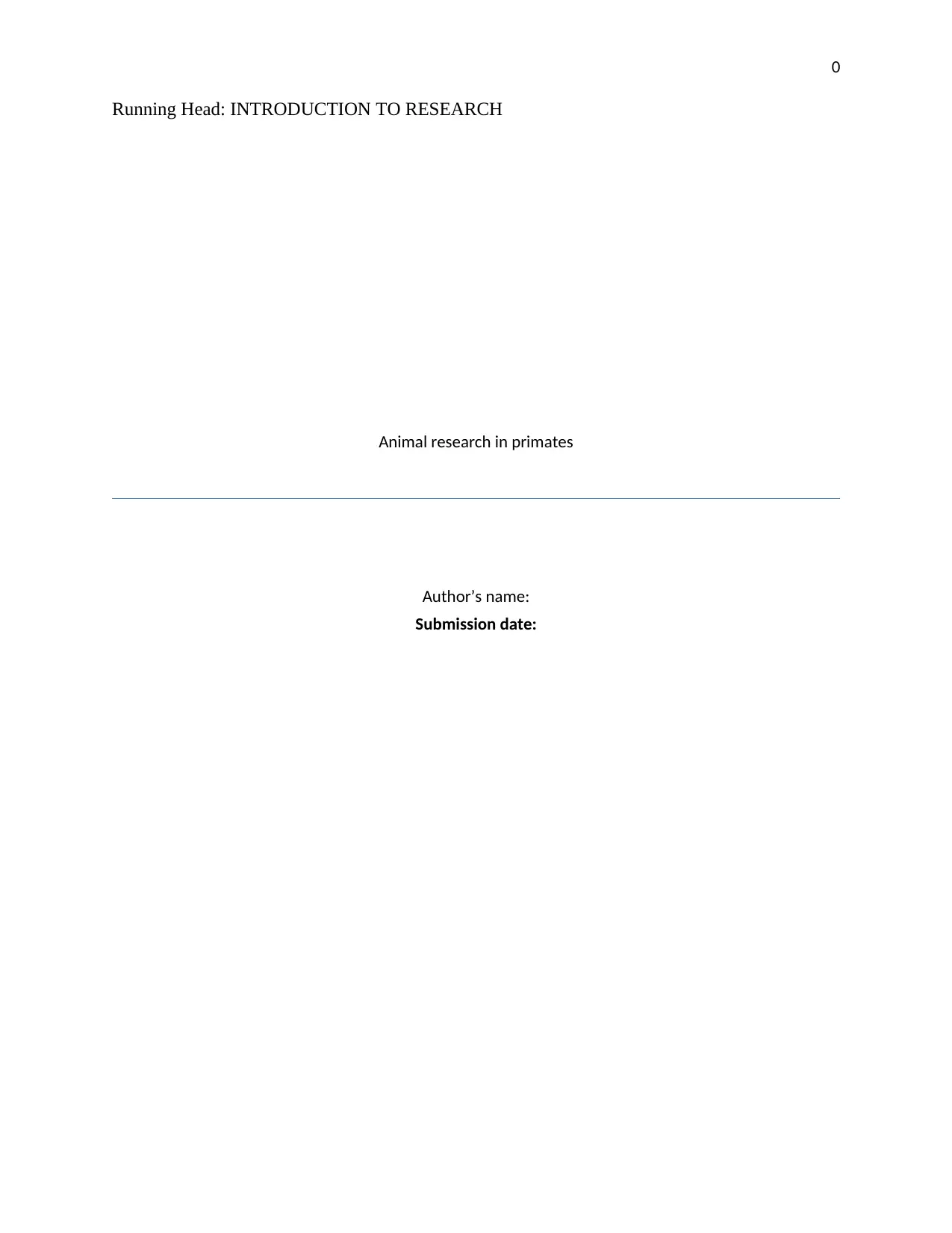
0
Running Head: INTRODUCTION TO RESEARCH
Animal research in primates
Author’s name:
Submission date:
Running Head: INTRODUCTION TO RESEARCH
Animal research in primates
Author’s name:
Submission date:
Paraphrase This Document
Need a fresh take? Get an instant paraphrase of this document with our AI Paraphraser

1
INTRODUCTION TO RESEARCH
Contents
1List of figures.............................................................................................................................................2
1.1 Broad scan......................................................................................................................................2
1.1.1 Research journal.............................................................................................................................2
1.1.2 Filing system...................................................................................................................................2
1.1.3 Bibliographic file from broad scan..................................................................................................3
1.2 Focused review......................................................................................................................................3
1.1.2 Updated filing system.....................................................................................................................3
1.2.2 Updated bibliographic from focused review..................................................................................4
Works Cited.................................................................................................................................................4
1.3 Selected paper 1....................................................................................................................................5
1.3.1 Problem definition..........................................................................................................................7
1.3.2 Overview of the proposed system..................................................................................................8
1.4 Selected paper 2....................................................................................................................................8
1.4.1 Experiments....................................................................................................................................9
1.5 Discussion............................................................................................................................................10
1.6 Conclusion...........................................................................................................................................12
INTRODUCTION TO RESEARCH
Contents
1List of figures.............................................................................................................................................2
1.1 Broad scan......................................................................................................................................2
1.1.1 Research journal.............................................................................................................................2
1.1.2 Filing system...................................................................................................................................2
1.1.3 Bibliographic file from broad scan..................................................................................................3
1.2 Focused review......................................................................................................................................3
1.1.2 Updated filing system.....................................................................................................................3
1.2.2 Updated bibliographic from focused review..................................................................................4
Works Cited.................................................................................................................................................4
1.3 Selected paper 1....................................................................................................................................5
1.3.1 Problem definition..........................................................................................................................7
1.3.2 Overview of the proposed system..................................................................................................8
1.4 Selected paper 2....................................................................................................................................8
1.4.1 Experiments....................................................................................................................................9
1.5 Discussion............................................................................................................................................10
1.6 Conclusion...........................................................................................................................................12
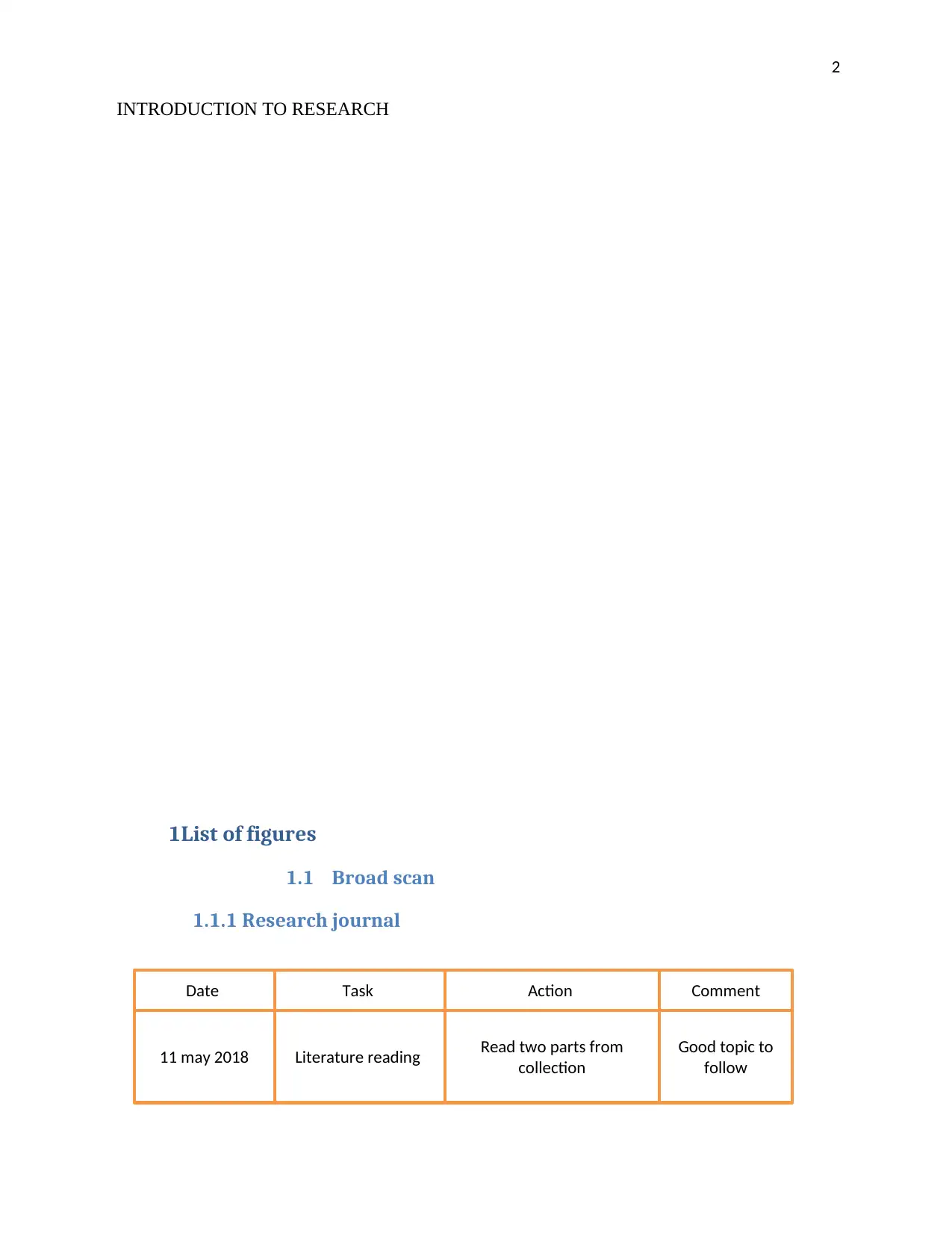
2
INTRODUCTION TO RESEARCH
1List of figures
1.1 Broad scan
1.1.1 Research journal
Date Task Action Comment
11 may 2018 Literature reading Read two parts from
collection
Good topic to
follow
INTRODUCTION TO RESEARCH
1List of figures
1.1 Broad scan
1.1.1 Research journal
Date Task Action Comment
11 may 2018 Literature reading Read two parts from
collection
Good topic to
follow
⊘ This is a preview!⊘
Do you want full access?
Subscribe today to unlock all pages.

Trusted by 1+ million students worldwide
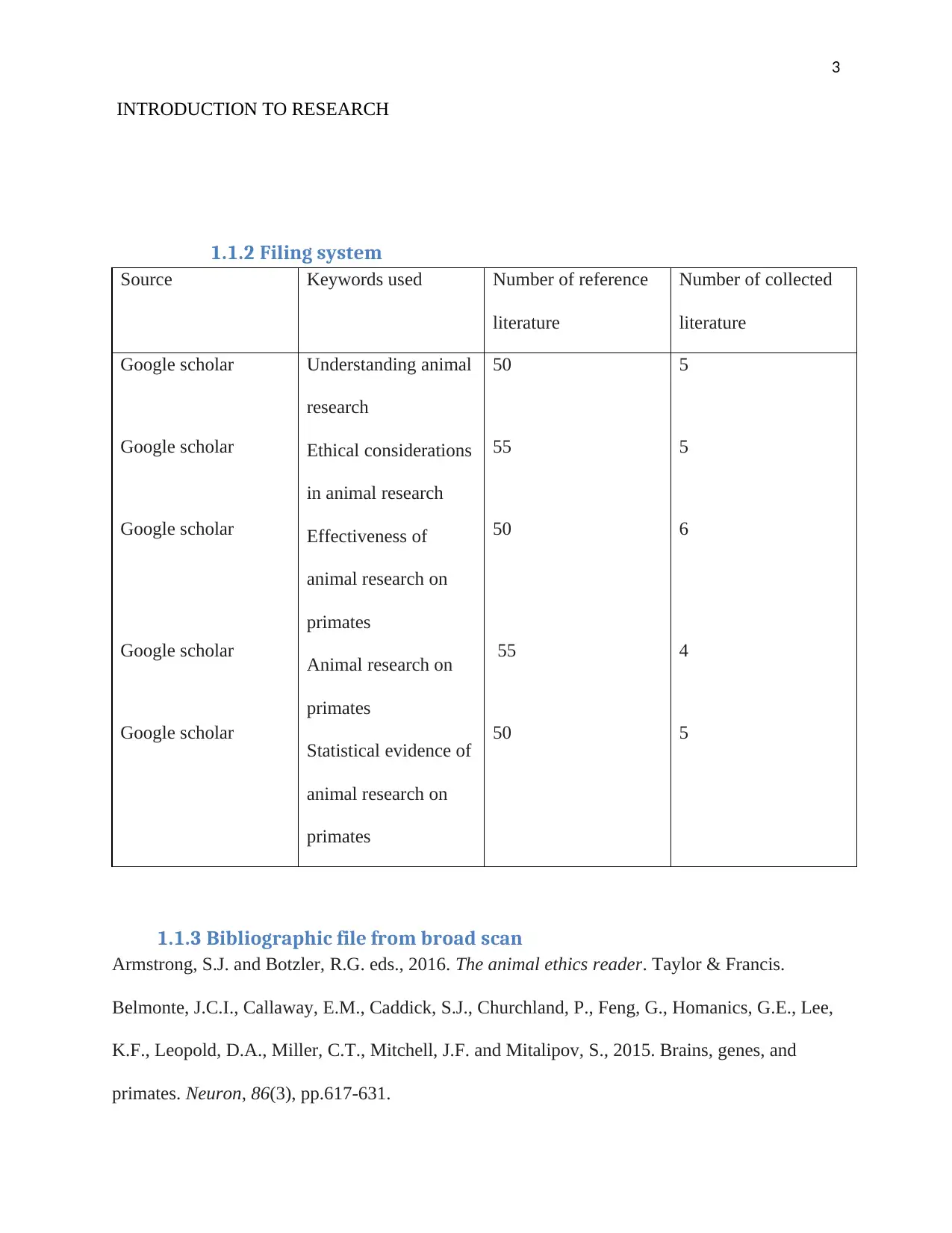
3
INTRODUCTION TO RESEARCH
1.1.2 Filing system
Source Keywords used Number of reference
literature
Number of collected
literature
Google scholar
Google scholar
Google scholar
Google scholar
Google scholar
Understanding animal
research
Ethical considerations
in animal research
Effectiveness of
animal research on
primates
Animal research on
primates
Statistical evidence of
animal research on
primates
50
55
50
55
50
5
5
6
4
5
1.1.3 Bibliographic file from broad scan
Armstrong, S.J. and Botzler, R.G. eds., 2016. The animal ethics reader. Taylor & Francis.
Belmonte, J.C.I., Callaway, E.M., Caddick, S.J., Churchland, P., Feng, G., Homanics, G.E., Lee,
K.F., Leopold, D.A., Miller, C.T., Mitchell, J.F. and Mitalipov, S., 2015. Brains, genes, and
primates. Neuron, 86(3), pp.617-631.
INTRODUCTION TO RESEARCH
1.1.2 Filing system
Source Keywords used Number of reference
literature
Number of collected
literature
Google scholar
Google scholar
Google scholar
Google scholar
Google scholar
Understanding animal
research
Ethical considerations
in animal research
Effectiveness of
animal research on
primates
Animal research on
primates
Statistical evidence of
animal research on
primates
50
55
50
55
50
5
5
6
4
5
1.1.3 Bibliographic file from broad scan
Armstrong, S.J. and Botzler, R.G. eds., 2016. The animal ethics reader. Taylor & Francis.
Belmonte, J.C.I., Callaway, E.M., Caddick, S.J., Churchland, P., Feng, G., Homanics, G.E., Lee,
K.F., Leopold, D.A., Miller, C.T., Mitchell, J.F. and Mitalipov, S., 2015. Brains, genes, and
primates. Neuron, 86(3), pp.617-631.
Paraphrase This Document
Need a fresh take? Get an instant paraphrase of this document with our AI Paraphraser
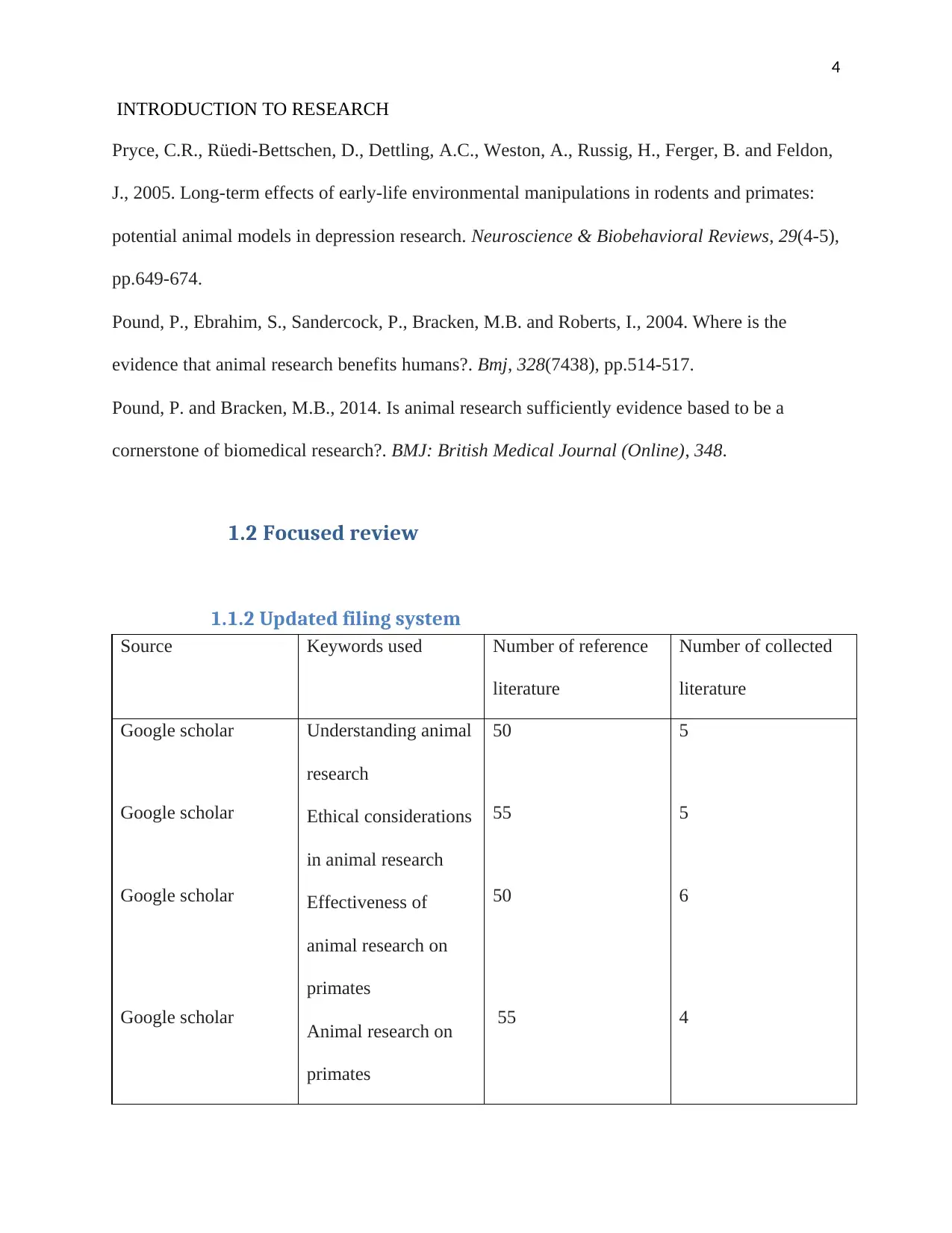
4
INTRODUCTION TO RESEARCH
Pryce, C.R., Rüedi-Bettschen, D., Dettling, A.C., Weston, A., Russig, H., Ferger, B. and Feldon,
J., 2005. Long-term effects of early-life environmental manipulations in rodents and primates:
potential animal models in depression research. Neuroscience & Biobehavioral Reviews, 29(4-5),
pp.649-674.
Pound, P., Ebrahim, S., Sandercock, P., Bracken, M.B. and Roberts, I., 2004. Where is the
evidence that animal research benefits humans?. Bmj, 328(7438), pp.514-517.
Pound, P. and Bracken, M.B., 2014. Is animal research sufficiently evidence based to be a
cornerstone of biomedical research?. BMJ: British Medical Journal (Online), 348.
1.2 Focused review
1.1.2 Updated filing system
Source Keywords used Number of reference
literature
Number of collected
literature
Google scholar
Google scholar
Google scholar
Google scholar
Understanding animal
research
Ethical considerations
in animal research
Effectiveness of
animal research on
primates
Animal research on
primates
50
55
50
55
5
5
6
4
INTRODUCTION TO RESEARCH
Pryce, C.R., Rüedi-Bettschen, D., Dettling, A.C., Weston, A., Russig, H., Ferger, B. and Feldon,
J., 2005. Long-term effects of early-life environmental manipulations in rodents and primates:
potential animal models in depression research. Neuroscience & Biobehavioral Reviews, 29(4-5),
pp.649-674.
Pound, P., Ebrahim, S., Sandercock, P., Bracken, M.B. and Roberts, I., 2004. Where is the
evidence that animal research benefits humans?. Bmj, 328(7438), pp.514-517.
Pound, P. and Bracken, M.B., 2014. Is animal research sufficiently evidence based to be a
cornerstone of biomedical research?. BMJ: British Medical Journal (Online), 348.
1.2 Focused review
1.1.2 Updated filing system
Source Keywords used Number of reference
literature
Number of collected
literature
Google scholar
Google scholar
Google scholar
Google scholar
Understanding animal
research
Ethical considerations
in animal research
Effectiveness of
animal research on
primates
Animal research on
primates
50
55
50
55
5
5
6
4
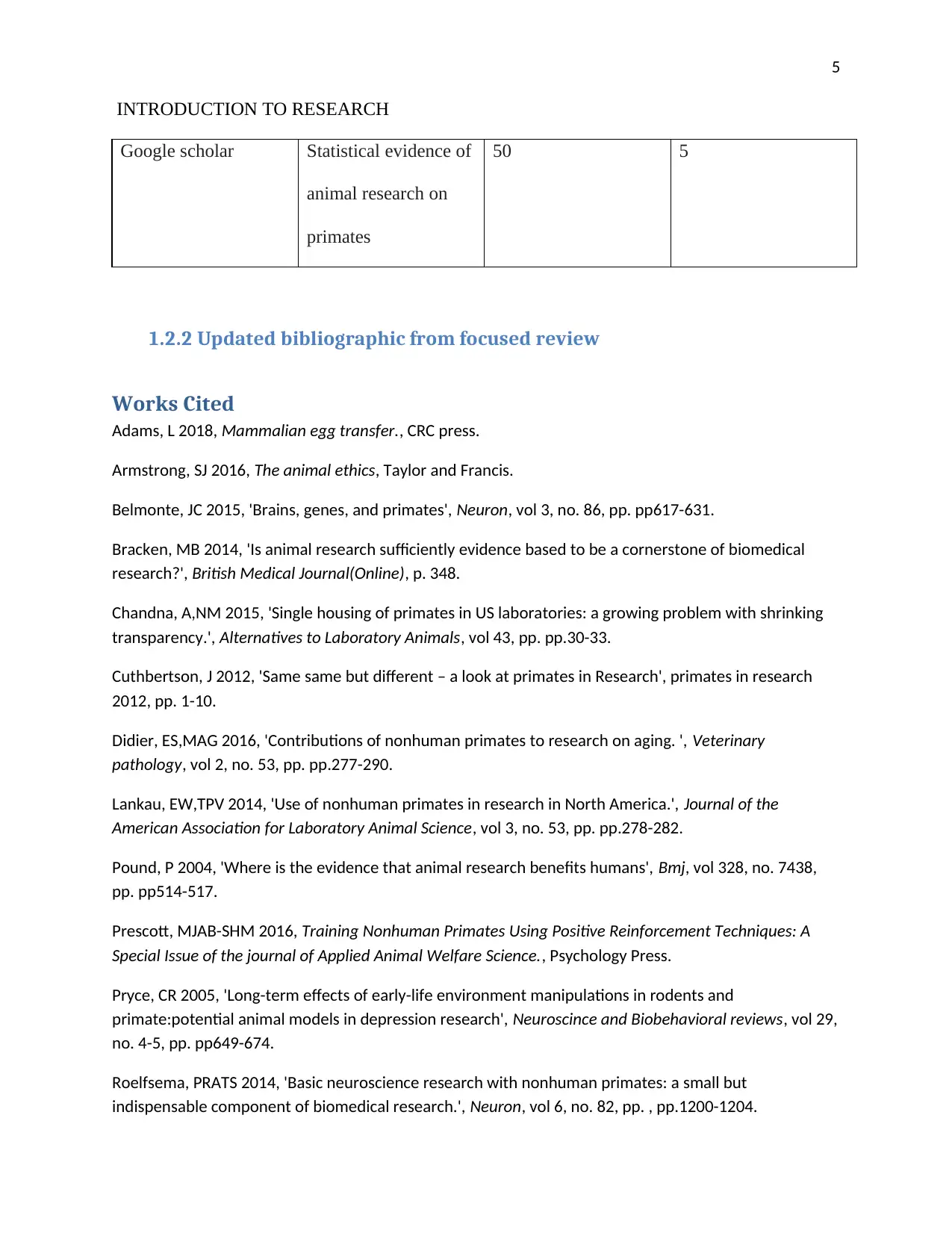
5
INTRODUCTION TO RESEARCH
Google scholar Statistical evidence of
animal research on
primates
50 5
1.2.2 Updated bibliographic from focused review
Works Cited
Adams, L 2018, Mammalian egg transfer., CRC press.
Armstrong, SJ 2016, The animal ethics, Taylor and Francis.
Belmonte, JC 2015, 'Brains, genes, and primates', Neuron, vol 3, no. 86, pp. pp617-631.
Bracken, MB 2014, 'Is animal research sufficiently evidence based to be a cornerstone of biomedical
research?', British Medical Journal(Online), p. 348.
Chandna, A,NM 2015, 'Single housing of primates in US laboratories: a growing problem with shrinking
transparency.', Alternatives to Laboratory Animals, vol 43, pp. pp.30-33.
Cuthbertson, J 2012, 'Same same but different – a look at primates in Research', primates in research
2012, pp. 1-10.
Didier, ES,MAG 2016, 'Contributions of nonhuman primates to research on aging. ', Veterinary
pathology, vol 2, no. 53, pp. pp.277-290.
Lankau, EW,TPV 2014, 'Use of nonhuman primates in research in North America.', Journal of the
American Association for Laboratory Animal Science, vol 3, no. 53, pp. pp.278-282.
Pound, P 2004, 'Where is the evidence that animal research benefits humans', Bmj, vol 328, no. 7438,
pp. pp514-517.
Prescott, MJAB-SHM 2016, Training Nonhuman Primates Using Positive Reinforcement Techniques: A
Special Issue of the journal of Applied Animal Welfare Science., Psychology Press.
Pryce, CR 2005, 'Long-term effects of early-life environment manipulations in rodents and
primate:potential animal models in depression research', Neuroscince and Biobehavioral reviews, vol 29,
no. 4-5, pp. pp649-674.
Roelfsema, PRATS 2014, 'Basic neuroscience research with nonhuman primates: a small but
indispensable component of biomedical research.', Neuron, vol 6, no. 82, pp. , pp.1200-1204.
INTRODUCTION TO RESEARCH
Google scholar Statistical evidence of
animal research on
primates
50 5
1.2.2 Updated bibliographic from focused review
Works Cited
Adams, L 2018, Mammalian egg transfer., CRC press.
Armstrong, SJ 2016, The animal ethics, Taylor and Francis.
Belmonte, JC 2015, 'Brains, genes, and primates', Neuron, vol 3, no. 86, pp. pp617-631.
Bracken, MB 2014, 'Is animal research sufficiently evidence based to be a cornerstone of biomedical
research?', British Medical Journal(Online), p. 348.
Chandna, A,NM 2015, 'Single housing of primates in US laboratories: a growing problem with shrinking
transparency.', Alternatives to Laboratory Animals, vol 43, pp. pp.30-33.
Cuthbertson, J 2012, 'Same same but different – a look at primates in Research', primates in research
2012, pp. 1-10.
Didier, ES,MAG 2016, 'Contributions of nonhuman primates to research on aging. ', Veterinary
pathology, vol 2, no. 53, pp. pp.277-290.
Lankau, EW,TPV 2014, 'Use of nonhuman primates in research in North America.', Journal of the
American Association for Laboratory Animal Science, vol 3, no. 53, pp. pp.278-282.
Pound, P 2004, 'Where is the evidence that animal research benefits humans', Bmj, vol 328, no. 7438,
pp. pp514-517.
Prescott, MJAB-SHM 2016, Training Nonhuman Primates Using Positive Reinforcement Techniques: A
Special Issue of the journal of Applied Animal Welfare Science., Psychology Press.
Pryce, CR 2005, 'Long-term effects of early-life environment manipulations in rodents and
primate:potential animal models in depression research', Neuroscince and Biobehavioral reviews, vol 29,
no. 4-5, pp. pp649-674.
Roelfsema, PRATS 2014, 'Basic neuroscience research with nonhuman primates: a small but
indispensable component of biomedical research.', Neuron, vol 6, no. 82, pp. , pp.1200-1204.
⊘ This is a preview!⊘
Do you want full access?
Subscribe today to unlock all pages.

Trusted by 1+ million students worldwide
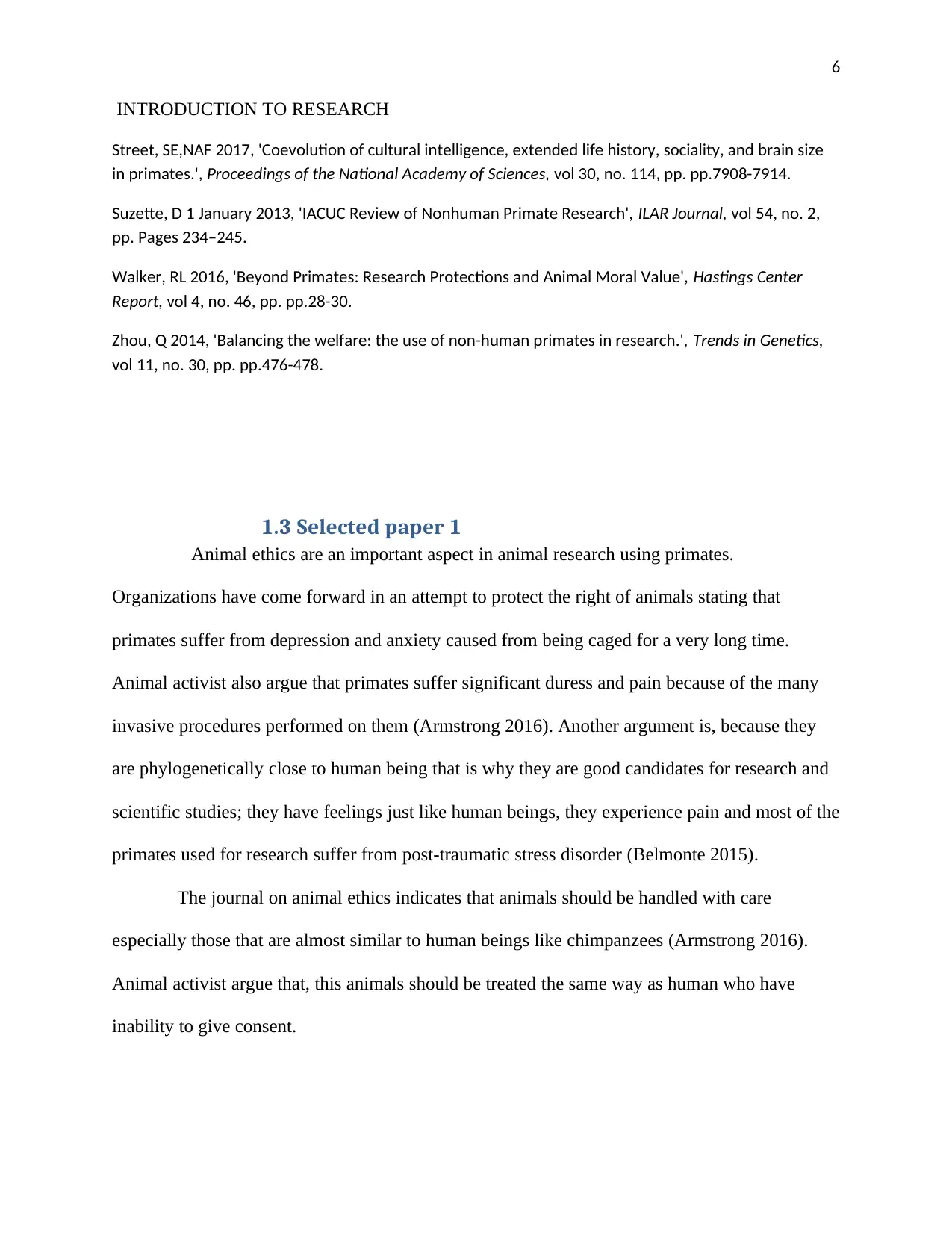
6
INTRODUCTION TO RESEARCH
Street, SE,NAF 2017, 'Coevolution of cultural intelligence, extended life history, sociality, and brain size
in primates.', Proceedings of the National Academy of Sciences, vol 30, no. 114, pp. pp.7908-7914.
Suzette, D 1 January 2013, 'IACUC Review of Nonhuman Primate Research', ILAR Journal, vol 54, no. 2,
pp. Pages 234–245.
Walker, RL 2016, 'Beyond Primates: Research Protections and Animal Moral Value', Hastings Center
Report, vol 4, no. 46, pp. pp.28-30.
Zhou, Q 2014, 'Balancing the welfare: the use of non-human primates in research.', Trends in Genetics,
vol 11, no. 30, pp. pp.476-478.
1.3 Selected paper 1
Animal ethics are an important aspect in animal research using primates.
Organizations have come forward in an attempt to protect the right of animals stating that
primates suffer from depression and anxiety caused from being caged for a very long time.
Animal activist also argue that primates suffer significant duress and pain because of the many
invasive procedures performed on them (Armstrong 2016). Another argument is, because they
are phylogenetically close to human being that is why they are good candidates for research and
scientific studies; they have feelings just like human beings, they experience pain and most of the
primates used for research suffer from post-traumatic stress disorder (Belmonte 2015).
The journal on animal ethics indicates that animals should be handled with care
especially those that are almost similar to human beings like chimpanzees (Armstrong 2016).
Animal activist argue that, this animals should be treated the same way as human who have
inability to give consent.
INTRODUCTION TO RESEARCH
Street, SE,NAF 2017, 'Coevolution of cultural intelligence, extended life history, sociality, and brain size
in primates.', Proceedings of the National Academy of Sciences, vol 30, no. 114, pp. pp.7908-7914.
Suzette, D 1 January 2013, 'IACUC Review of Nonhuman Primate Research', ILAR Journal, vol 54, no. 2,
pp. Pages 234–245.
Walker, RL 2016, 'Beyond Primates: Research Protections and Animal Moral Value', Hastings Center
Report, vol 4, no. 46, pp. pp.28-30.
Zhou, Q 2014, 'Balancing the welfare: the use of non-human primates in research.', Trends in Genetics,
vol 11, no. 30, pp. pp.476-478.
1.3 Selected paper 1
Animal ethics are an important aspect in animal research using primates.
Organizations have come forward in an attempt to protect the right of animals stating that
primates suffer from depression and anxiety caused from being caged for a very long time.
Animal activist also argue that primates suffer significant duress and pain because of the many
invasive procedures performed on them (Armstrong 2016). Another argument is, because they
are phylogenetically close to human being that is why they are good candidates for research and
scientific studies; they have feelings just like human beings, they experience pain and most of the
primates used for research suffer from post-traumatic stress disorder (Belmonte 2015).
The journal on animal ethics indicates that animals should be handled with care
especially those that are almost similar to human beings like chimpanzees (Armstrong 2016).
Animal activist argue that, this animals should be treated the same way as human who have
inability to give consent.
Paraphrase This Document
Need a fresh take? Get an instant paraphrase of this document with our AI Paraphraser
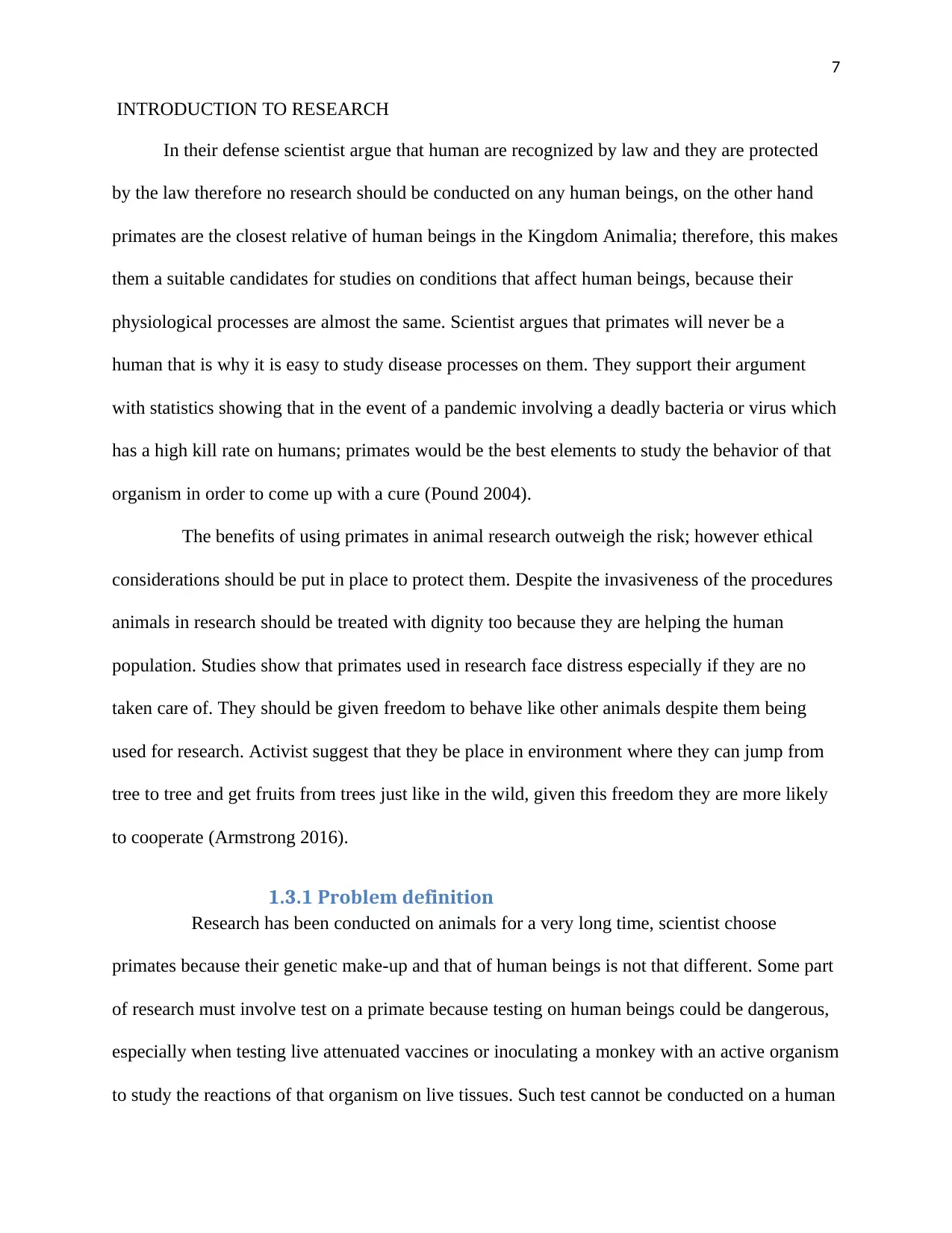
7
INTRODUCTION TO RESEARCH
In their defense scientist argue that human are recognized by law and they are protected
by the law therefore no research should be conducted on any human beings, on the other hand
primates are the closest relative of human beings in the Kingdom Animalia; therefore, this makes
them a suitable candidates for studies on conditions that affect human beings, because their
physiological processes are almost the same. Scientist argues that primates will never be a
human that is why it is easy to study disease processes on them. They support their argument
with statistics showing that in the event of a pandemic involving a deadly bacteria or virus which
has a high kill rate on humans; primates would be the best elements to study the behavior of that
organism in order to come up with a cure (Pound 2004).
The benefits of using primates in animal research outweigh the risk; however ethical
considerations should be put in place to protect them. Despite the invasiveness of the procedures
animals in research should be treated with dignity too because they are helping the human
population. Studies show that primates used in research face distress especially if they are no
taken care of. They should be given freedom to behave like other animals despite them being
used for research. Activist suggest that they be place in environment where they can jump from
tree to tree and get fruits from trees just like in the wild, given this freedom they are more likely
to cooperate (Armstrong 2016).
1.3.1 Problem definition
Research has been conducted on animals for a very long time, scientist choose
primates because their genetic make-up and that of human beings is not that different. Some part
of research must involve test on a primate because testing on human beings could be dangerous,
especially when testing live attenuated vaccines or inoculating a monkey with an active organism
to study the reactions of that organism on live tissues. Such test cannot be conducted on a human
INTRODUCTION TO RESEARCH
In their defense scientist argue that human are recognized by law and they are protected
by the law therefore no research should be conducted on any human beings, on the other hand
primates are the closest relative of human beings in the Kingdom Animalia; therefore, this makes
them a suitable candidates for studies on conditions that affect human beings, because their
physiological processes are almost the same. Scientist argues that primates will never be a
human that is why it is easy to study disease processes on them. They support their argument
with statistics showing that in the event of a pandemic involving a deadly bacteria or virus which
has a high kill rate on humans; primates would be the best elements to study the behavior of that
organism in order to come up with a cure (Pound 2004).
The benefits of using primates in animal research outweigh the risk; however ethical
considerations should be put in place to protect them. Despite the invasiveness of the procedures
animals in research should be treated with dignity too because they are helping the human
population. Studies show that primates used in research face distress especially if they are no
taken care of. They should be given freedom to behave like other animals despite them being
used for research. Activist suggest that they be place in environment where they can jump from
tree to tree and get fruits from trees just like in the wild, given this freedom they are more likely
to cooperate (Armstrong 2016).
1.3.1 Problem definition
Research has been conducted on animals for a very long time, scientist choose
primates because their genetic make-up and that of human beings is not that different. Some part
of research must involve test on a primate because testing on human beings could be dangerous,
especially when testing live attenuated vaccines or inoculating a monkey with an active organism
to study the reactions of that organism on live tissues. Such test cannot be conducted on a human
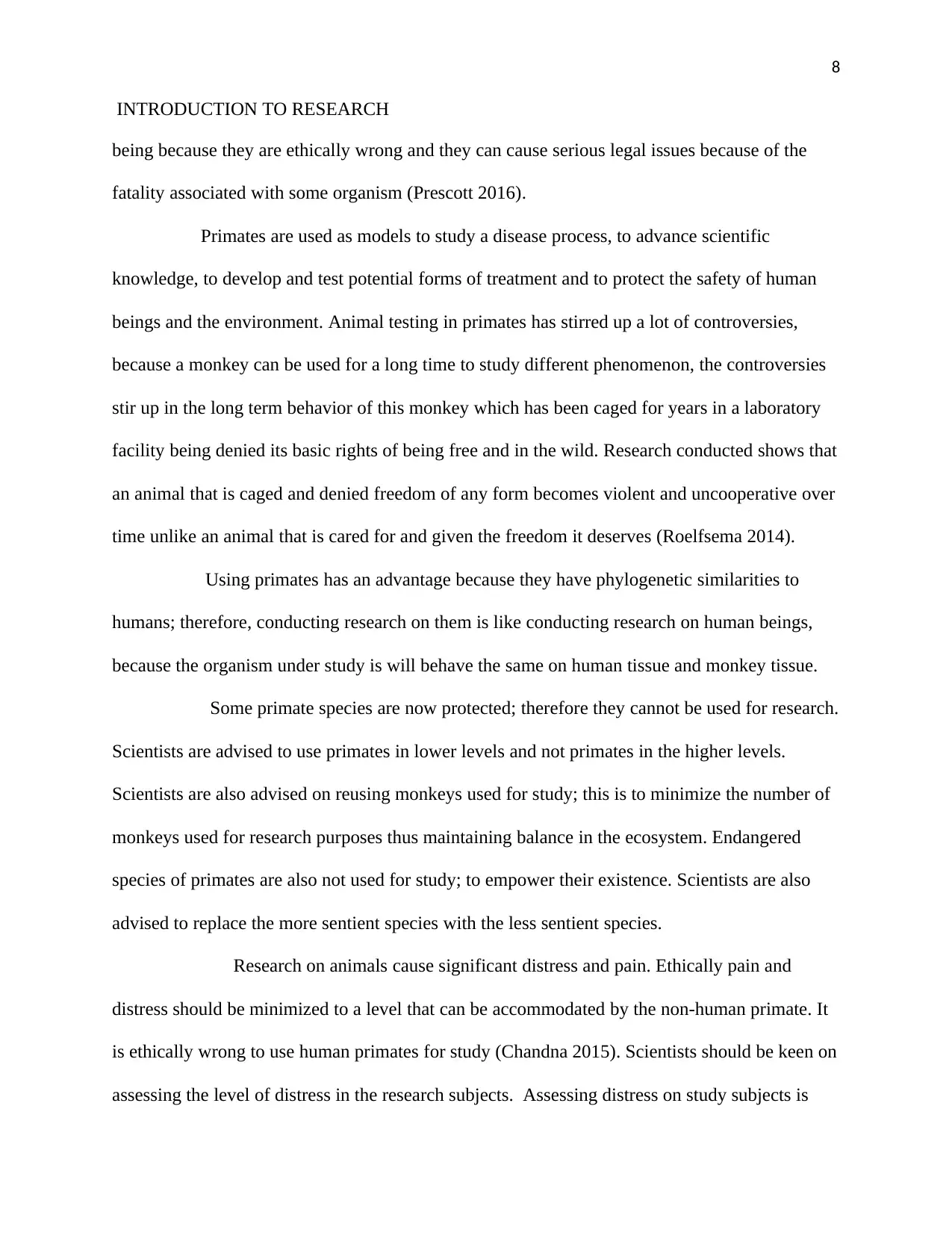
8
INTRODUCTION TO RESEARCH
being because they are ethically wrong and they can cause serious legal issues because of the
fatality associated with some organism (Prescott 2016).
Primates are used as models to study a disease process, to advance scientific
knowledge, to develop and test potential forms of treatment and to protect the safety of human
beings and the environment. Animal testing in primates has stirred up a lot of controversies,
because a monkey can be used for a long time to study different phenomenon, the controversies
stir up in the long term behavior of this monkey which has been caged for years in a laboratory
facility being denied its basic rights of being free and in the wild. Research conducted shows that
an animal that is caged and denied freedom of any form becomes violent and uncooperative over
time unlike an animal that is cared for and given the freedom it deserves (Roelfsema 2014).
Using primates has an advantage because they have phylogenetic similarities to
humans; therefore, conducting research on them is like conducting research on human beings,
because the organism under study is will behave the same on human tissue and monkey tissue.
Some primate species are now protected; therefore they cannot be used for research.
Scientists are advised to use primates in lower levels and not primates in the higher levels.
Scientists are also advised on reusing monkeys used for study; this is to minimize the number of
monkeys used for research purposes thus maintaining balance in the ecosystem. Endangered
species of primates are also not used for study; to empower their existence. Scientists are also
advised to replace the more sentient species with the less sentient species.
Research on animals cause significant distress and pain. Ethically pain and
distress should be minimized to a level that can be accommodated by the non-human primate. It
is ethically wrong to use human primates for study (Chandna 2015). Scientists should be keen on
assessing the level of distress in the research subjects. Assessing distress on study subjects is
INTRODUCTION TO RESEARCH
being because they are ethically wrong and they can cause serious legal issues because of the
fatality associated with some organism (Prescott 2016).
Primates are used as models to study a disease process, to advance scientific
knowledge, to develop and test potential forms of treatment and to protect the safety of human
beings and the environment. Animal testing in primates has stirred up a lot of controversies,
because a monkey can be used for a long time to study different phenomenon, the controversies
stir up in the long term behavior of this monkey which has been caged for years in a laboratory
facility being denied its basic rights of being free and in the wild. Research conducted shows that
an animal that is caged and denied freedom of any form becomes violent and uncooperative over
time unlike an animal that is cared for and given the freedom it deserves (Roelfsema 2014).
Using primates has an advantage because they have phylogenetic similarities to
humans; therefore, conducting research on them is like conducting research on human beings,
because the organism under study is will behave the same on human tissue and monkey tissue.
Some primate species are now protected; therefore they cannot be used for research.
Scientists are advised to use primates in lower levels and not primates in the higher levels.
Scientists are also advised on reusing monkeys used for study; this is to minimize the number of
monkeys used for research purposes thus maintaining balance in the ecosystem. Endangered
species of primates are also not used for study; to empower their existence. Scientists are also
advised to replace the more sentient species with the less sentient species.
Research on animals cause significant distress and pain. Ethically pain and
distress should be minimized to a level that can be accommodated by the non-human primate. It
is ethically wrong to use human primates for study (Chandna 2015). Scientists should be keen on
assessing the level of distress in the research subjects. Assessing distress on study subjects is
⊘ This is a preview!⊘
Do you want full access?
Subscribe today to unlock all pages.

Trusted by 1+ million students worldwide
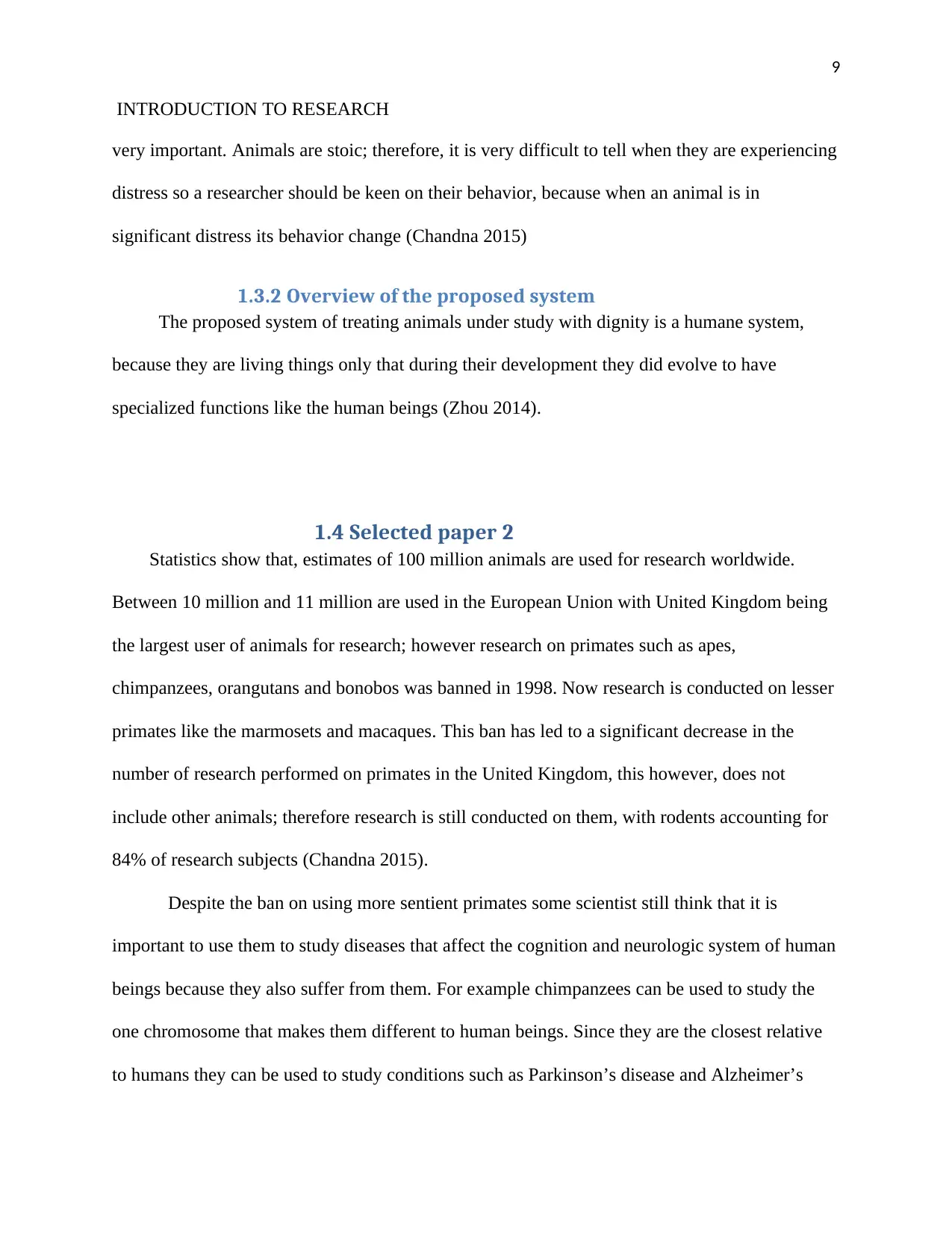
9
INTRODUCTION TO RESEARCH
very important. Animals are stoic; therefore, it is very difficult to tell when they are experiencing
distress so a researcher should be keen on their behavior, because when an animal is in
significant distress its behavior change (Chandna 2015)
1.3.2 Overview of the proposed system
The proposed system of treating animals under study with dignity is a humane system,
because they are living things only that during their development they did evolve to have
specialized functions like the human beings (Zhou 2014).
1.4 Selected paper 2
Statistics show that, estimates of 100 million animals are used for research worldwide.
Between 10 million and 11 million are used in the European Union with United Kingdom being
the largest user of animals for research; however research on primates such as apes,
chimpanzees, orangutans and bonobos was banned in 1998. Now research is conducted on lesser
primates like the marmosets and macaques. This ban has led to a significant decrease in the
number of research performed on primates in the United Kingdom, this however, does not
include other animals; therefore research is still conducted on them, with rodents accounting for
84% of research subjects (Chandna 2015).
Despite the ban on using more sentient primates some scientist still think that it is
important to use them to study diseases that affect the cognition and neurologic system of human
beings because they also suffer from them. For example chimpanzees can be used to study the
one chromosome that makes them different to human beings. Since they are the closest relative
to humans they can be used to study conditions such as Parkinson’s disease and Alzheimer’s
INTRODUCTION TO RESEARCH
very important. Animals are stoic; therefore, it is very difficult to tell when they are experiencing
distress so a researcher should be keen on their behavior, because when an animal is in
significant distress its behavior change (Chandna 2015)
1.3.2 Overview of the proposed system
The proposed system of treating animals under study with dignity is a humane system,
because they are living things only that during their development they did evolve to have
specialized functions like the human beings (Zhou 2014).
1.4 Selected paper 2
Statistics show that, estimates of 100 million animals are used for research worldwide.
Between 10 million and 11 million are used in the European Union with United Kingdom being
the largest user of animals for research; however research on primates such as apes,
chimpanzees, orangutans and bonobos was banned in 1998. Now research is conducted on lesser
primates like the marmosets and macaques. This ban has led to a significant decrease in the
number of research performed on primates in the United Kingdom, this however, does not
include other animals; therefore research is still conducted on them, with rodents accounting for
84% of research subjects (Chandna 2015).
Despite the ban on using more sentient primates some scientist still think that it is
important to use them to study diseases that affect the cognition and neurologic system of human
beings because they also suffer from them. For example chimpanzees can be used to study the
one chromosome that makes them different to human beings. Since they are the closest relative
to humans they can be used to study conditions such as Parkinson’s disease and Alzheimer’s
Paraphrase This Document
Need a fresh take? Get an instant paraphrase of this document with our AI Paraphraser

10
INTRODUCTION TO RESEARCH
disease in human and they can be used to study the treatment process (Pryce 2005). Scientist
who support this argue that research involving human beings should be conducted on animals
that have a close genetic make up to human beings because they are likely to yield more accurate
results.
Experts think that using non-human primate is the only hope for making
discoveries in neurodegenerative disorders, immunization and vaccines development and
immune functions (Roelfsema 2014).
1.4.1 Experiments
In the United States more than 105000 primates are imprisoned and caged in laboratories
for research and medical studies (Lankau 2014). Some of these animals are breed and born in the
laboratories where they are taken away from their mothers and brought up for research purposes.
These animals adapt better compared to those that are snatched away from their families in the
forest and taken to laboratories for research purposes. Research on primates has led to increased
illegal pouching which and illegal sale of animals for research purposes.
These animals are deprived of the freedom to sit, stand and move around, the trauma
kicks in and the animal may become depressed or it may become aggressive. An animal that
doesn’t adapt is killed because it cannot be taken back to the wild after being inoculated with
something that is dangerous to human life. They are denied their basic rights of being animals.
That is why animal welfare suggests that in as much as they are human beings primates should
be treated ethically just like humans with no ability to give consent.
Research shows that 90% of monkeys in laboratory exhibit abnormal behavior
because of psychological torture; being in a cage all day and all night. Physiological torture
especially during the period they hunted in the forest and being mishandled in the laboratory.
INTRODUCTION TO RESEARCH
disease in human and they can be used to study the treatment process (Pryce 2005). Scientist
who support this argue that research involving human beings should be conducted on animals
that have a close genetic make up to human beings because they are likely to yield more accurate
results.
Experts think that using non-human primate is the only hope for making
discoveries in neurodegenerative disorders, immunization and vaccines development and
immune functions (Roelfsema 2014).
1.4.1 Experiments
In the United States more than 105000 primates are imprisoned and caged in laboratories
for research and medical studies (Lankau 2014). Some of these animals are breed and born in the
laboratories where they are taken away from their mothers and brought up for research purposes.
These animals adapt better compared to those that are snatched away from their families in the
forest and taken to laboratories for research purposes. Research on primates has led to increased
illegal pouching which and illegal sale of animals for research purposes.
These animals are deprived of the freedom to sit, stand and move around, the trauma
kicks in and the animal may become depressed or it may become aggressive. An animal that
doesn’t adapt is killed because it cannot be taken back to the wild after being inoculated with
something that is dangerous to human life. They are denied their basic rights of being animals.
That is why animal welfare suggests that in as much as they are human beings primates should
be treated ethically just like humans with no ability to give consent.
Research shows that 90% of monkeys in laboratory exhibit abnormal behavior
because of psychological torture; being in a cage all day and all night. Physiological torture
especially during the period they hunted in the forest and being mishandled in the laboratory.
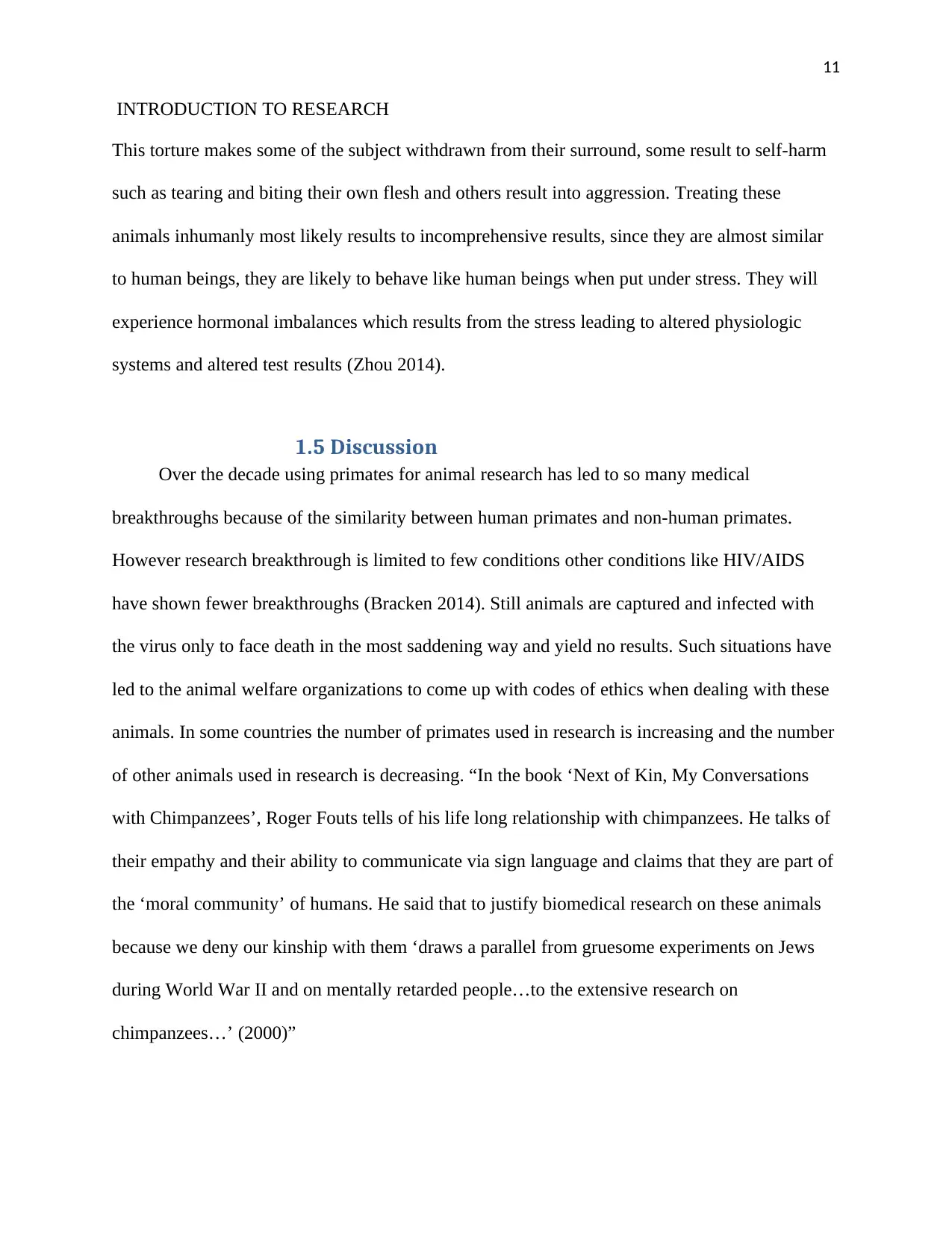
11
INTRODUCTION TO RESEARCH
This torture makes some of the subject withdrawn from their surround, some result to self-harm
such as tearing and biting their own flesh and others result into aggression. Treating these
animals inhumanly most likely results to incomprehensive results, since they are almost similar
to human beings, they are likely to behave like human beings when put under stress. They will
experience hormonal imbalances which results from the stress leading to altered physiologic
systems and altered test results (Zhou 2014).
1.5 Discussion
Over the decade using primates for animal research has led to so many medical
breakthroughs because of the similarity between human primates and non-human primates.
However research breakthrough is limited to few conditions other conditions like HIV/AIDS
have shown fewer breakthroughs (Bracken 2014). Still animals are captured and infected with
the virus only to face death in the most saddening way and yield no results. Such situations have
led to the animal welfare organizations to come up with codes of ethics when dealing with these
animals. In some countries the number of primates used in research is increasing and the number
of other animals used in research is decreasing. “In the book ‘Next of Kin, My Conversations
with Chimpanzees’, Roger Fouts tells of his life long relationship with chimpanzees. He talks of
their empathy and their ability to communicate via sign language and claims that they are part of
the ‘moral community’ of humans. He said that to justify biomedical research on these animals
because we deny our kinship with them ‘draws a parallel from gruesome experiments on Jews
during World War II and on mentally retarded people…to the extensive research on
chimpanzees…’ (2000)”
INTRODUCTION TO RESEARCH
This torture makes some of the subject withdrawn from their surround, some result to self-harm
such as tearing and biting their own flesh and others result into aggression. Treating these
animals inhumanly most likely results to incomprehensive results, since they are almost similar
to human beings, they are likely to behave like human beings when put under stress. They will
experience hormonal imbalances which results from the stress leading to altered physiologic
systems and altered test results (Zhou 2014).
1.5 Discussion
Over the decade using primates for animal research has led to so many medical
breakthroughs because of the similarity between human primates and non-human primates.
However research breakthrough is limited to few conditions other conditions like HIV/AIDS
have shown fewer breakthroughs (Bracken 2014). Still animals are captured and infected with
the virus only to face death in the most saddening way and yield no results. Such situations have
led to the animal welfare organizations to come up with codes of ethics when dealing with these
animals. In some countries the number of primates used in research is increasing and the number
of other animals used in research is decreasing. “In the book ‘Next of Kin, My Conversations
with Chimpanzees’, Roger Fouts tells of his life long relationship with chimpanzees. He talks of
their empathy and their ability to communicate via sign language and claims that they are part of
the ‘moral community’ of humans. He said that to justify biomedical research on these animals
because we deny our kinship with them ‘draws a parallel from gruesome experiments on Jews
during World War II and on mentally retarded people…to the extensive research on
chimpanzees…’ (2000)”
⊘ This is a preview!⊘
Do you want full access?
Subscribe today to unlock all pages.

Trusted by 1+ million students worldwide
1 out of 16
Your All-in-One AI-Powered Toolkit for Academic Success.
+13062052269
info@desklib.com
Available 24*7 on WhatsApp / Email
![[object Object]](/_next/static/media/star-bottom.7253800d.svg)
Unlock your academic potential
Copyright © 2020–2025 A2Z Services. All Rights Reserved. Developed and managed by ZUCOL.

